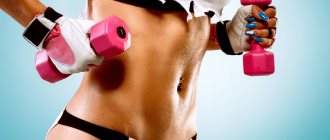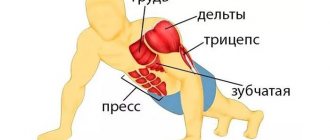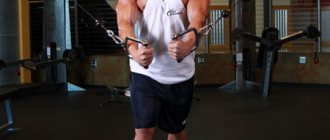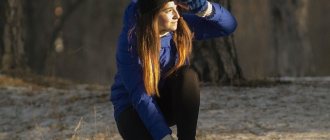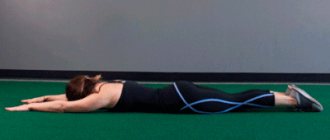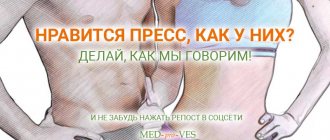Why is it important to develop your forearms? In this article, you will learn what role these muscles play, and also get acquainted with exercises that stimulate their growth, regardless of genetic characteristics.
Massive forearms are considered a sign and calling card of a real bodybuilder or athlete. Indeed, developed, muscular forearms create a feeling of gigantic strength. And from a functional point of view, they allow the athlete to work with ever-increasing weights. The forearms increase grip strength and are thus involved in pulling exercises. On stage, underdeveloped forearms immediately catch the eye and also disrupt the proportions of the body.
If you want bigger muscles, you will have to do specific exercises and training for your forearms. In addition to being one of the most difficult muscles to grow, their shape and size limit are determined by genetics. And those whom nature has not endowed with good heredity will have to work hard during training.
Anatomy of arm muscles
The arm muscles have many large, visible muscles that help us with everyday activities, such as changing clothes or lifting weights.
The complex design of the forearms allows us to perform completely different movements of our hands. Our fingers are also amazingly designed to allow us to grip barbells and dumbbells. All parts of the forearm, hand, fingers interact so harmoniously with each other that it is a real ensemble of bones, ligaments and tendons.
34 complex muscles provide varied mobility of our fingers and hands. They are so strong that trained people can support their weight by grasping something with a few fingertips.
| Brachioradialis (brachioradialis muscle) | It is located on the front of the forearm. It starts from the shoulder, or rather from the outer part of it, after which it makes an intersection through the elbow and extends to the radius. Involved in elbow flexion and also helps rotate the forearm up/down. |
| Wrist support | It is thanks to this muscle that we can supinate while pumping the biceps, since it rotates the hand outward. Resembles a thin plate in the shape of a triangle. It is attached from our elbow to the thumb side. |
| Extensor carpi radialis longus | Be located next to the brachioradialis on the side of the triceps muscle. Participates in the outward extension of our hand. |
| Flexor carpi radialis and ulnaris | These muscles are visible on the biceps side on the inside of our forearms. They work when you need to bend your hands towards yourself. They also perform pronation of the hand (turn it outward), this is their additional function. |
| Extensors and flexors of the fingers | These muscles are located throughout the forearm, on its outer and inner sides. They provide grip strength, but add little volume. |
| Pronator teres | The main function of this muscle is to turn the hand inward from the side of our little finger. Also involved in forearm flexion. |
| Pronator quadratus | Similar to the round one, but differs in that it has the shape of a plate with four corners and is located next to the palm. |
Just as with the calf muscles, the forearms require frequent and heavy loads. Despite the fact that when working with heavy weights (especially with various rows without wrist belts), the forearms are also involved, it is still better to do special exercises.
Best exercises
Let's move from theory to practice and look at how to build powerful forearms. To do this, you need only the most effective and efficient exercises. Of course, this does not mean that you need to get carried away and do all the movements in one workout. Very often, in pursuit of how to pump up huge forearms, athletes literally overdo it and, as a result, do not get a decent return.
It is important to remember that for a small muscle group it is enough to do 1-2 basic movements and 1-2 isolating ones. This rule applies to everyone, both athletes who train their forearm at home and those who work out in the gym.
Finger exercisers
There are many modifications of mini-simulators that allow you to quickly pump up your forearms at home and strengthen your grip well. Of course, you won’t get huge volumes with such devices, but you can quickly eliminate the weak link that prevents you from training.
The variety of finger exercisers is truly impressive. The simplest is the carpal expander or “donut”, which is considered one of the most effective. This is a great option for pumping up your forearms at home without iron. You can also find exercise machines with a spring, where the compression force is much greater. They are also good for home workouts.
It is important to remember that you do not need to buy complex and expensive exercise equipment; wrist expanders and “donuts” will be quite enough. In pursuit of how to quickly pump up their forearms, athletes often come up with rather outlandish devices.
For example, simulators that are attached to the wrist and the first phalanges of the fingers, between which cords or springs are stretched. Despite their unusual appearance, they do not provide any advantage over conventional expanders, although they are much more expensive.
Holding the bar
This is one of the simplest exercises for the forearms, which can even be adapted to be performed at home. It is important to remember that you need to hold the barbell with an open grip, that is, on your fingers. This technique is a simplified replacement for the finger hang on the bar, which requires a strong grip.
Usually the hold is done in two modes, performing it either for 35-40 seconds with a submaximal weight (so that after 30 seconds it is very difficult to hold the weight), or until failure.
You can pump your forearms not only with a barbell, but also with any weight, so the bar can be replaced with a kettlebell or dumbbells.
Pancake Hold
This is not just one of the best exercises, but also the most common way to test the actual development of your forearms. The thickness of the plate is ideal for training your grip. Try to use the maximum weight and move on to heavier pancakes over time.
For those athletes who want to pump up their forearms at home, the exercise will be available only if they can find an analogue of the pancake. It is important that the projectile does not allow you to use a full grip. The weight should be supported on the fingers.
Neck extenders
The use of expanders has gained incredible popularity in recent years. In most cases, they are enough to fully load the lower arm and hand while training other muscle groups. This allows you to develop a muscle group in the so-called passive mode.
For example, when performing biceps curls with a large bar (EZ is not suitable), the forearm will be loaded no worse than when doing flexions and extensions. Moreover, this option is also effective in that it ensures a uniform increase in arm strength and mass.
It is important to remember that the extenders must be rigid so that the grip is secure and the bar does not slip out of your hands. Try to choose a material that will not slip. Also, beginners should avoid ball-shaped extenders; without a strong grip, they are unlikely to be able to use them to their full potential.
Farmer's Walk with Dumbbells
Thanks to this exercise, strongmen never have problems with weak forearms. Moreover, it is in this sport that athletes have the strongest grip, which allows them to perform all exercises (atlas spheres, deadlifts, holding equipment with an outstretched arm, etc.).
It makes sense that this forearm exercise for men is incredibly effective, even when done with dumbbells.
Even if you do a farmer's walk with dumbbells to pump up your forearms at home, the exercise should be as hard as possible. Otherwise, the exercise will not be effective.
It is optimal to do a walk in a timed manner, for example, from 30 to 50 seconds. If you can perform the exercise after 50 seconds, then the weight was chosen incorrectly and the dumbbells should be heavier. The key conditions for a proper farmer walk should be:
- Straight back;
- Neck in a neutral position (look straight ahead, at the horizon);
- Chest straightened forward and shoulder blades pulled together.
You also need to remember that it is better not to take a walk if you have underdeveloped core muscles and problems with the spine (especially in the lumbar region).
Why pump up your forearms?
Statistics show that one of the first things girls pay attention to in a man when meeting or getting to know him is his hands, and this is not surprising.
Reason #1. Aesthetic

Let's speak frankly. Most bodybuilders develop their forearms to make them look bigger and ultimately balance out their physique. Massive forearms create the impression of enormous strength, that is, they reflect the physical capabilities of a person. In addition, the forearms, as well as the neck, are often the only visible parts of the body. But when athletes start doing wrist curls, few of them think about effectiveness and safety.
Reason #2. Safety and grip strength
Strong forearms allow you to perform various exercises on other muscle groups. Often the forearms can be a bit of a weak link, limiting your exercise options. For example, to properly work your back, you need reverse-grip pull-ups and bent-over barbell rows, in which strong forearms play a leading role.
Reverse grip pull-ups
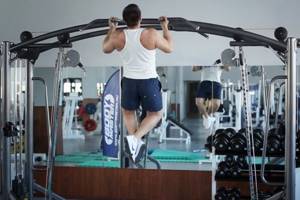
Strong forearms require development of the entire upper body, and the athlete can lift more weight without risk of injury. Thus, forearm exercises are the key to safe and more effective training.
Bent-over barbell row
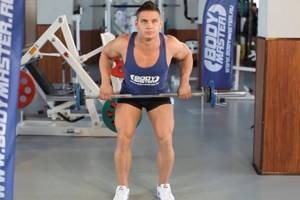
As with the calf muscles, the forearms require frequent and heavy loads. Although the forearms are involved when lifting heavy weights (especially during various deadlifts without wrist straps), it is better to perform specific exercises for the forearms.
Home workout for forearms

There are several fairly simple but important recommendations that you need to know about before starting classes:
- When pumping up the forearms, many of the same muscles are used as when working on the biceps. And if you focus on one group, the result of this approach will be overtraining. Therefore, both biceps and forearm should be trained on different days, and not on the same day.
- To work out your forearms when you plan to exercise at home, you need to have a dumbbell at your disposal, but it would be better to also have a barbell with weights.
- To load the forearms, it should be noted that this muscle group is small. Therefore, in each approach it is necessary to do many repetitions, that is, from 15 to 20.
- It is necessary to train the forearms not before the biceps, but after.
The correct approach to building training is also important. It is better to do basic exercises first, and only then isolation exercises.
The best forearm exercises in the gym
The forearms are a fairly complex group of small muscles with several functions. The brachialis and brachioradialis muscles help flex the arm at the elbow and assist the forearm during flexion. The pronator teres muscle helps the forearm in the prone position, as well as when bending the arm at the elbow joint. The flexor muscles palmaris longus, flexor carpi radialis, and flexor carpi ulnaris flex the palm, while the extensor ulnaris and extensor carpi radialis brevis muscles extend the palm. And each of these muscles must be loaded to one degree or another with special exercises.
Extensor exercises
These muscles consist of eight heads: extensor digitorum, extensor carpi radialis longus, extensor carpi radialis brevis, extensor carpi ulnaris, extensor index finger, extensor carpi radialis longus, extensor pollicis longus and extensor pollicis brevis. These muscles extend beyond the forearm, so it is very important to develop them with the following exercises
Barbell Palms Down Wrist Curl
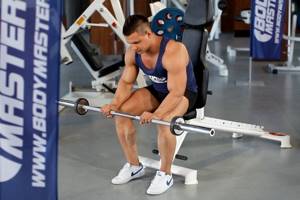
Reverse grip biceps curl

Standing Pronated Grip Dumbbell Raise
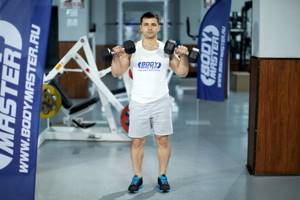
To vary the work and stimulate further growth of the extensor muscles, perform one of these exercises each workout with a palms-down grip on the bar. Your forearms should rest completely on your knees. Lower the weight so that the muscles are greatly stretched. Then extend your wrists for maximum contraction. If you're using dumbbells, work with each arm in turn.
Extensor exercises
This is the largest muscle of the forearm, stretching along the entire length of its inner part. The flexors consist of six heads: flexor digitorum superficialis, flexor digitorum profundus, flexor carpi radialis, flexor carpi ulnaris, palmaris longus and flexor pollicis longus. The best exercises for the forearm flexor muscles:
Wrist curl with a barbell while sitting on a bench, palms up
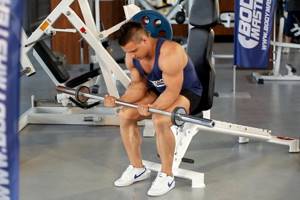
Bend the wrists on the lower block while sitting on a bench
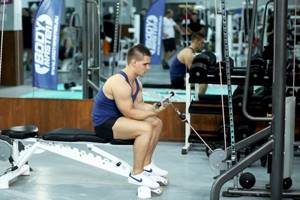
Wrist curl while sitting on a bench with dumbbells, palms up
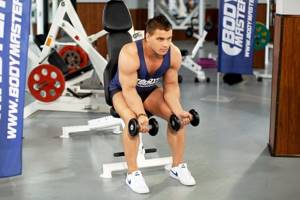
To perform this movement, hold the bar as you would for a normal barbell lift. Place your forearms on your thighs and bend your wrists upward as hard as possible. Tighten your muscles and return to the starting position.
Exercises on the brachioradialis muscle
The brachioradialis muscle is located on the outside of the forearm and is a thick, rope-like muscle that can be easily seen when the arm is fully extended. It consists of only one head - the brachioradialis. Recommended exercises for the brachioradialis muscle:
Reverse grip barbell lift
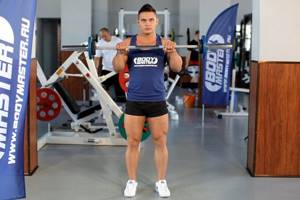
Biceps curls on a Scott bench with an EZ barbell with a reverse grip
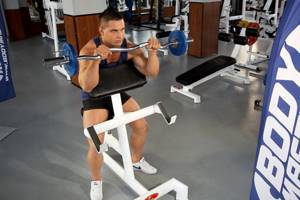
Reverse grip biceps curl
Alternating dumbbell curls while standing
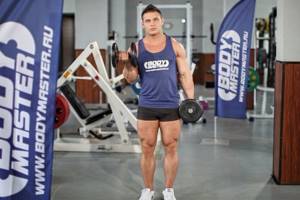
Ultimately, you yourself will find your ideal exercises by trying all of the above. We are completely sure of one thing, they definitely work.
Forearm exercises
We will start with a regular towel, since these exercises are considered one of the most effective.
Types of exercises with a towel
- Hangs (on two or one arm)
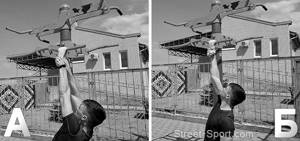
- Various pull-ups on a towel
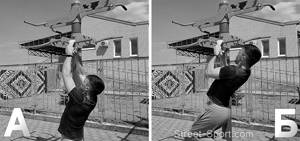
- Regular wrist curls with towel

- Hammer curls with towel
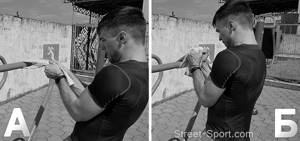
- Proning the hand
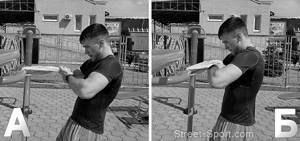
- Supination of the hand
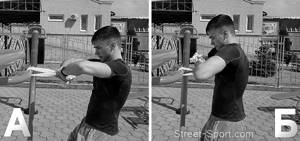
Let's also look at exercises with rubber loops that can be performed both outdoors and at home.
Types of exercises with rubber loops
- Reverse grip curls

- Hammer grip curls
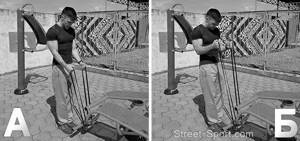
- Cross curls

- Proning (normal and power)

- Supination (regular and power)
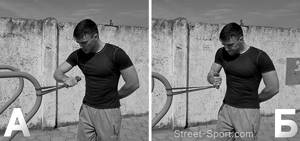
- Wrist extension
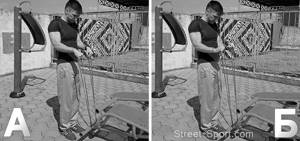
- Wrist curls
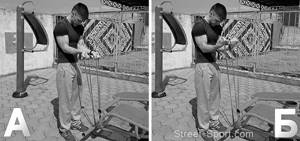
And finally, we should also consider exercises for which we only need a horizontal bar. You can use them anytime and anywhere if you have nothing at hand other than a regular crossbar.
Types of exercises on the horizontal bar
- Hangs on one hand or on fingers
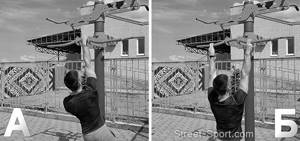
- Rolling and rolling fingers on the bar
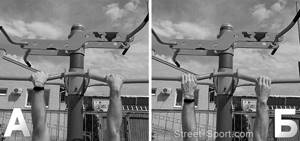
- Alternating change of grip on the horizontal bar
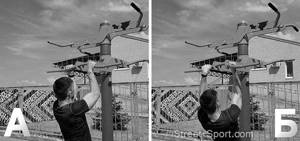
- Straight-grip pull-ups
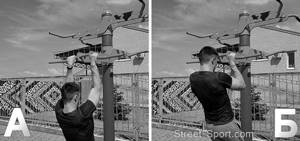
- Pull-ups/hangs with elastic bandages
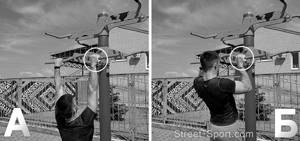
- Wrist curls on a low horizontal bar
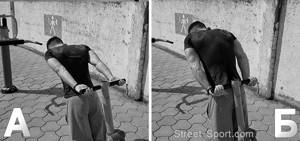
Bodymaster.ru recommends Training Plans:
Buy collapsible dumbbells . With this amazing equipment, you will have a lot of opportunities to quickly pump up your arm muscles at home, diversify the number of available movements with new exercises and complexes with dumbbells for the arms.
Use a thick bar. This will make your grip more difficult, and as a result of regular training, the size of your forearm will increase. If you don't have a thick bar at hand, simply wrap a towel around a regular bar. Similar equipment can be thought of at home.
Useful video from Yuri Spasokukotsky on developing grip and forearm strength using the Axel Apollo deadlift.
Wind the rope onto a weighted roller. Stand up straight and grab the roller with your palms facing down. Raise your arms parallel to the floor. Start winding the rope onto the roller by turning each hand up and down in turn. When the weight reaches the roller, slowly unwind the rope using the same wrist movements.
Winding rope onto a wrist roller
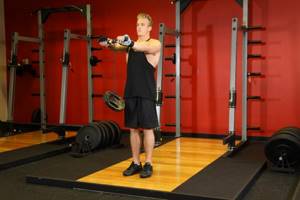
Essentially, this device is a heavy plate attached to a small handle with a thin rope. Slowly raise the handle with straight arms to shoulder level and begin to wind the rope onto the roller by turning your hands. When the weight reaches the roller, slowly unwind the rope with reverse movements of your wrists. Then relax and repeat the exercise.
Box. Hitting the punching bag repeatedly will also help develop forearm strength. Incorporate these exercises into your program from time to time and you will soon see progress. For example, 50 uppercuts with each hand perfectly develop the forearm flexors.
Use isometric exercises. Sets of isometric exercises for the forearms allow you to strengthen the muscle frame, increase strength and improve athletic performance without grueling hours of training in the gym. Its effectiveness and accessibility to everyone has been proven over time, as well as its widespread use in yoga, bodybuilding, fitness, rehabilitation programs, martial arts and strength training.
Effective workout
Now let's look at the basic rules for doing forearm exercises for men, both at home and in the gym. The first thing to remember is that the forearms are the same muscle group as everyone else.
It belongs to small muscle groups, so the difference lies only in the frequency of training and the quality of work. It is quite clear that you do not need to do the same amount of work as for the back, legs, and even arms.
When experienced strength athletes with huge forearms advise how to properly train this muscle group, the answer is almost always clear - powerful basic movements with submaximal weights as a base, isolating movements for finishing.
The maximum you can do is train this muscle group twice a week. Muscles need time to grow and recover, so when asked whether it is possible to exercise your forearms every day, the answer is quite clear - no. Of course, if the main goal of the training is not overtraining and lack of growth.
It is important to remember that when you do powerful strength movements (pull-ups, rows, etc.), the lower arms are already under load. In this case, it is better to limit yourself to one additional workout per week, for example, pumping your forearms with dumbbells after working out your biceps and triceps. It is not advisable to train this muscle group when you have been doing heavy deadlifts.
Forearm training - A
Wrist curl with a barbell while sitting on a bench, palms up
- 3 sets of 12-15 reps
- Body part: Forearms and wrists Equipment: Barbell
Reverse grip biceps curl
- 3 sets of 12-15 reps
- Body Part: Biceps Equipment: Block
Alternating dumbbell curls while standing with a Hammer grip
- 3 sets of 12-15 reps
- Body part: Biceps Equipment: Dumbbells
Bend the wrists on the lower block while sitting on a bench
- 2 sets of 12-15 reps, forward and reverse grip
- Body Part: Forearms and Wrists Equipment: Block
Add to Calendar * Add to My Workouts * Print Workout
* — The service is in beta testing
As for the timing of working on the forearms, that is a completely different story: it is better to train them once a week, preferably at the end of the biceps workout.
Forearm training - B
Standing Pronated Grip Dumbbell Raise
- 3 sets of 12-15 reps
- Body part: Biceps Equipment: Dumbbells
Wrist curl while sitting on a bench with dumbbells, palms up
- 3 sets of 12-15 reps
- Body part: Forearms and wrists Equipment: Dumbbells
Standing biceps curl with reverse grip
- 3 sets of 12-15 reps
- Body part: Biceps Equipment: Barbell
Add to Calendar * Add to My Workouts * Print Workout
* — The service is in beta testing
You can also work on the muscles of the forearms on separate days, for example, 2 times a week, or combine them with calf training.
The Best Forearm Training Scheme
There is no one ideal scheme that would allow you to pump up large forearms. As with any other muscle, it is necessary to progress slowly and regularly, change programs, alternate loads, use different types of exercises, etc.
It is quite obvious that simply performing wrist flexions and extensions with dumbbells or a barbell will not be enough. At best, this is suitable for a good completion of forearm training, but not as a main load. Also remember, developing strength is always a priority over increasing muscle size.
Let's look at two types of training that can be considered necessary. The first workout will be shock training; it cannot be called work only on the forearms. Rather, it is a general load with the help of powerful basic exercises, where the lower arm anatomically cannot help but be involved in the work.
If this is a lagging muscle group, you can work them additionally at the end of the workout with not too difficult exercises (flexion/extension, any holds, hanging on your fingers, etc.). When using bar extensions, you can do only the main workout, without finishing.
The second type of training is simple, where you will only work the muscles of the forearms. At first with the main basic movements, at the end with isolating movements.
There is no point in going into detail about the first type of training; it will depend on the overall program, because it is not aimed at developing the forearms. For example, a plan usually looks like this:
- Deadlift 4*8, 7, 5, 3;
- Any other types of rows with bar extensions – 3*12, 10, 8;
- Farmer's walk (time or maximum distance);
- Hold the pancake for the maximum time.
Simply put, the main task is to introduce forearm muscle training and exercises for these muscles into your program, of course, if you do not train at home and have access to all the sports equipment. Then you need to choose only the available exercises
The second type of training can be called targeted training of the target muscle group. For the gym, an example of the most effective workout would look like this:
- Finger hang/towel hang for as long as possible (old school exercise for developing grip strength). For beginners, you can replace it with holding the barbell on your fingers;
- Lifting the barbell for biceps with a reverse grip with extenders 3*12*10*8;
- Farmer's walk to failure (if you can put grip extenders on the dumbbells, the exercise will be even more useful for training grip strength);
- Holding a pancake – 3 sets to failure;
- Curl with dumbbell 3*15, 12, 10;
- Extension with a dumbbell 3*15, 12, 10.
Home workouts are most often inferior to working out in the gym due to the lack of equipment. How to pump up your forearms at home? Everything will depend on the available shells. The minimum set consists of:
- Crossbars;
- Dumbbells or weights.
The crossbar will give you the opportunity to do finger hangs and towel hangs, which are very good for developing the lower arm and grip strength. Dumbbells will give you access to curls and extensions, which are a good example of isolation exercises.
At the end of your workout, it is always advisable to do several sets to failure with a manual resistance band or donut. This will help pump maximum blood into the muscles and completely deplete them, which will have a great effect on muscle growth.
Also, when training your arm muscles at home, do not forget to do hammer curls and reverse grip biceps curls. While these exercises may not be the best, they also work your forearms.
We decided not only to share the theory with you in this article, but also to show that we are practitioners. Especially for you, we filmed a cool arm workout with Maxim Pechenkin. We advise you to take a look at this complex, as you will get acquainted with many exercises and tricks that you have not tried yet!
Forearm workout - B
Barbell Palms Down Wrist Curl
- 3 sets of 12-15 reps
- Body part: Forearms and wrists Equipment: Barbell
Bend the wrists on the lower block while sitting on a bench
- 3 sets of 12-15 reps
- Body Part: Forearms and Wrists Equipment: Block
Reverse grip biceps curl
- 3 sets of 12-15 reps
- Body Part: Biceps Equipment: Block
Add to Calendar * Add to My Workouts * Print Workout
* — The service is in beta testing
